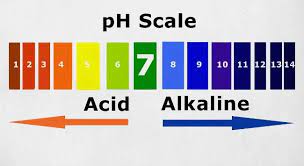Alkaline & Acid Levels In The Body
Posted by Just Fitter on
The human body is built to naturally maintain a healthy balance of acidity and alkalinity. The lungs and kidneys play a key role in this process. A normal blood pH level is 7.35 to 7.45 on a scale of 0 to 14, where 0 is the most acidic and 14 is the most basic. This value can vary slightly in either direction.
If the lungs or kidneys are malfunctioning, your blood’s pH level can become imbalanced. Disruption in your acid-base balance can lead to medical conditions known as acidosis and alkalosis. Both conditions require treatment from a medical professional, not simply dietary changes. Certain medical conditions, such as diabetic ketoacidosis, can cause your blood pH level to become imbalanced.
Importance of PH Balance
Alkaline is the body's natural and pure state. However, many factors in today's society contribute to an over acidic environment. These factors range from the abundance of processed foods, the overuse of antibiotics, the natural process of aging, and even stress. It is important for us to assist our body in creating and maintaining a healthy pH ratio of 70:30, alkaline to acid.
Most diseases, illnesses, and bad bacteria thrive in an over acidic environment. When pH levels are unbalanced, it is mostly in the case of being too acidic. This causes the body to borrow crucial minerals from organs, bones, and tissue to try and neutralize the acid and remove it from the body. Over acidity weakens all systems and can be seen in acute symptoms such as yeast/fungi overgrowth (candida among others), chronic fatigue, slow elimination, hormonal concerns, premature aging, free radical damage (may lead to cancerous mutations), weight gain, bladder and kidney damage such as kidney stones, diabetes, joint pain, and lactic acid build up.
Different Body Fluid PH
Although the pH of blood ranges from 7.35-7.45, the pH of other body fluids is different. pH indicates the level of H+ ions, where low pH indicates too many H+ ions and high pH indicates too many OH- ions. If the pH levels drop below 6.9, it can lead to coma. However, different body fluids have different pH values. The pH of saliva is ranges from 6.5 to 7.5. After swallowing, the food reaches the stomach where upper and lower parts of stomach have different pH values. The upper part has a pH of 4−6.5, while the lower part is highly acidic with a pH of 1.5−4.0. It then enters the intestine which is slightly alkaline, with a pH of 7−8.5. Maintaining the pH values of different regions is critical for their function.
Mechanisms in maintaining the body PH
-
Buffer Systems - Buffers may help in regulating pH during minor physiological changes, such as during breath holding (which increases the CO2 in the blood), exercise (which increases lactic acid in the blood), or when gastric acid is secreted.
-
Respiratory Control - CO2 dissociates into carbonic acid in the tissues. Thus, presence of more CO2 makes the blood more acidic. That is the reason when we hold the breath for long durations, the CO2 levels increase in the blood lowering our pH leading to fainting. On the other hand during alkalosis or increased pH, the breathing may get slow in order to increase the CO2 levels and reduce the alkalinity. However, low breathing rate could also lead to low oxygen levels which could be detrimental. Thus, respiration provides an important control to regulate the pH levels.
-
Renal Control - The renal system regulates the pH of extracellular fluid. The changes in pH induced by the respiratory system are in minutes, while the changes induced by the renal system are in the order of days. If the acidity of the fluids is high, kidney secretes H+ ions, while if the carbonate ion levels are high it retains H+ ions and secretes HCO3 ions. Although this process is slow but it can prove an effective mode to regulate pH. One limitation of renal regulation is that the pH of urine cannot be below 4.4. Thus, strong acids can be removed by reacting with basic salts of phosphoric acid or by addition of base (NH3) to urine.
Types of abnormalities in Acid- Base Balance
-
Acidosis - the blood pH is low or there is too much acid in the blood.
-
Respiratory Acidosis - caused by your lungs not being able to remove enough carbon dioxide when you exhale. This can occur when your lungs are affected by a disease or other disorder. Can also be caused by taking narcotics or sleep medications. Brain and nervous system disorders that cause breathing problems may also lead to respiratory acidosis.
-
Metabolic Acidosis - is a buildup of acid in the body that originates in the kidneys. It occurs when your body can’t get rid of excess acid or loses too much base
-
Alkalosis - the blood pH is high or there is too much base in the blood.
-
Respiratory alkalosis - occurs when there’s too little carbon dioxide in your blood. Causes of respiratory alkalosis include hyperventilation due to anxiety, aspirin overdose, high fever, and possibly even pain.
-
Metabolic alkalosis - occurs when bicarbonate levels in your blood get too high or your body loses too much acid. It can be brought by a long period of vomiting, overuse of diuretics, or an overactive adrenal gland.
Different tests to diagnose PH Imbalance
-
Arterial Blood Gas - to look at oxygen and carbon dioxide levels and blood pH.
-
Basic Metabolic Panel - to check kidney function and nutrient levels.
-
Urinalysis - to check for proper elimination of acids and bases.
-
Urine PH Level tests - to measure alkalinity and acidity of urine
Alkaline Diet
The study says that consuming a diet rich in alkaline foods can not only prevent kidney diseases but also results in an increase in growth hormone levels, prevention of muscle loss and can even help deal with chronic pain and inflammation.This diet allows you to maintain the balance in your body. Here is a list of alkaline rich food that you need to add into your diet:
-
Green Leafy Vegetables - spinach, lettuce,kale, celery, cabbage, collard and mustard green.
-
Cauliflower/ Brocolli -they contain immense amounts of vitamins A, C, k and folate and phytochemicals plant compounds that are valuable in lowering inflammation and avert the risk of cancer.
-
Citrus Fruits - lemon, sweet lime and oranges overpowered with vitamin C that helps in detoxifying the system and offers respite from heartburn and acidity.
-
Root Vegetables - sweet potato, beets, radish, turnips and carrots are an amazing source of alkaline foods which facilitates to keep up the pH balance
-
Nuts - the huge array of antioxidants, protein and plant sterols present in almonds, walnuts and cashews regulate blood sugar spikes, improve heart health and manages weight.
Conclusion:
The human body is built to naturally maintain a healthy balance of acidity and alkalinity. It is important to keep the PH Balance at bay to prevent illnesses and diseases caused by high acid or base in blood. It is important to have self checked or even do home testing to make sure that PH Level is balanced.
Reference:
https://www.news-medical.net/health/pH-in-the-Human-Body.aspx









